HESA Ababil
| HESA Ababil | |
|---|---|
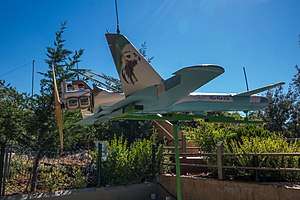 | |
| A Hezbollah Ababil-2 UAV, twin-tail variant with surveillance payload, on display at Mleeta, Lebanon. This specific drone is described as a Mirsad-1. | |
| Role | multirole UAV |
| National origin | Iran |
| Manufacturer | HESA Isfahan factory |
| Design group | Iran Aircraft Manufacturing Industrial Company |
| First flight | 1980s |
| Introduction | disputed |
| Status | In service |
| Primary users | Iranian Armed Forces Sudan Syria Iraq |
| Produced | 1980s–present |
| Number built | 370 (2006)[1] |
The HESA Ababil (Persian: ابابیل, "swallow") is an Iranian single-engine multirole tactical UAV manufactured by Iran Aircraft Manufacturing Industrial Company (HESA). The Ababil comes in two main lines, the Ababil-2 and the Ababil-3, which each have a number of variants.
The Ababil program was begun during the Iran-Iraq War. The Ababil-2, developed in the 1990s, has rudimentary surveillance capabilities and can be used as a loitering munition, but is mainly used as a target drone. The larger and more capable Ababil-3, introduced in the 2000s, was designed for ISR use and has improved surveillance capabilities.[1] Overall, the Ababil is "a pretty rough-and-ready system" – cheap, simple, and easy to use.[2]
The Ababil-2 and Ababil-3 have been widely exported to governments and non-state actors in the Middle East and elsewhere.[1] The Ababil has been used in the 2006 Lebanon War, the Iraq War, and the Sudanese, Syrian, Iraqi, and Yemeni civil wars.[1]
Development
The early history of the Ababil is unclear. Jane's reports that the Ababil program was begun at Qods Aviation Industries in 1986 and the first delivery was in 1993.[3] Iranian military expert Galen Wright writes that the program began at Iran Electronics Industries in the mid-1980s and began mass production in 1986, with possible use in the Iran-Iraq War.[1]
Design
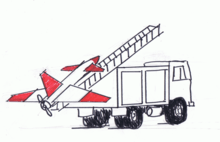
The Ababil has a cylindrical fuselage, a sweptback vertical fin, and a pusher engine.[3] It is powered by a simple two-bladed pusher propeller with a rear-mounted wing and a front canard for good stall, stability and maneuverability characteristics. All variants have a range of over 100 km[1] and all variants have all-metal construction, except for the Ababil-T, which is composite (fiberglass).[3]
The Ababil can be launched from a zero-length JATO platform or a Mercedes Benz 911 pneumatic truck launcher.[3] The rocket launch system can be used from a ship deck and can be assembled or broken down for portability. For recovery, a parachute provides a descent rate of 4 m/s, or skids can be used for conventional landings on a runway or field. Some airframes have also been seen with landing gear.[1]
Operational history
Lebanon
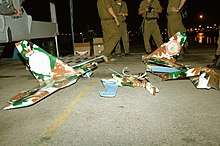
Hezbollah acquired Ababil-2 drones (twin-tail variant) in 2002,[4] and operated them under the Mirsad-1 designation. Israel has said that Hezbollah received at least 12 Ababils before the 2006 Lebanon War.[5] Three Ababils were launched during the conflict.
The first Ababil was shot down by an Israeli F-16 on August 7, 2006 off the coast of Northern Israel. The second Ababil crashed inside Lebanon on August 13. The third Ababil deployed by Hezbollah was shot down by another F-16 hours later just inside Israel's northern border.[5] By 2018, Hezbollah stated that the Mirsad-1 had been retired from service.[6]
Hezbollah has also built a large airstrip in Lebanon's Bekaa Valley. There is speculation that the aistrip could support larger, runway-launched Ababil-3 UAVs.[7] Hezbollah is not definitively known to operate the Ababil-3.
Sudan
The Ababil-3 is in service with Sudan. In 2008, an Ababil-3 crashed or was shot down while on a surveillance mission.[1][8]
On March 18, 2012 another Sudanese Ababil was lost in action. Sudanese rebels said they downed it using ground fire, while the Sudanese government said it was due to mechanical failure.[9]
Iraq

On March 16, 2009, an American F-16 operating in Iraq shot down an Iranian Ababil 3 drone on February 25, 2009 that had been flying through Iraqi airspace for "almost an hour and 10 minutes."[10] The drone crashed about 60 miles northeast of Baghdad, 12 miles inside Iraqi territory near the town of Balad Ruz in Diyala province. Officials at Iraq's Defense and Interior ministries suggested that the drone might have been scouting for routes to smuggle Iranian weapons into the country.[11] The New York Times, however, speculated that the drone was monitoring Iranian dissidents in Iraq, such as those at Camp Ashraf, which is located near where the drone crashed.[12] Abdul Aziz Mohammed Jassim, head of military operations at the Iraqi defense ministry stated that since the drone, "crossed 10 km into Iraq, it's most likely that its entrance was a mistake."[13]
More recently, Ababil-3 UAVs have been used extensively in the Iraqi Civil War.[14] Their use began in summer 2014, shortly after the Fall of Mosul, from Rasheed Air Base.[15]
Iran
Iran is the primary operator of Ababil UAVs. Iran operates large numbers of Ababil-2 UAVs, mostly for training air defense crews, and operates Ababil-3 UAVs for surveillance use.[1]
Syria
Ababil-3 UAVs have been used in the Syrian Civil War since 2012.[16] They have been used heavily[1] and are some of the most commonly used UAVs in the war.[17] They are especially commonly seen over Damascus.[18]
Gaza
On 14 December 2014, Hamas militants flew an unmanned air vehicle over a parade in Gaza marking the 27th anniversary of the organization's establishment. Israeli sources identified the aircraft as an Iranian-made Ababil.[19]
Variants
The Ababil is built in a number of poorly documented variants.[lower-alpha 1]
Ababil-1
The Ababil-1 was an obscure loitering munition built in the 1980s. Its specifications are not known, there are no know photographs, and it is unknown if it was ever used in combat. It is believed to be out of service.[1]
Ababil-2
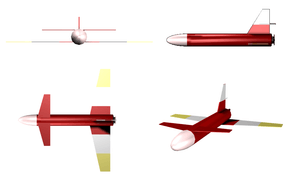
The Ababil-2 has an improved flight-control system. Jane's reports that the Ababil-2 had its first flight in 1997 while Galen Wright writes that it entered production in 1992. Both sources agree the Ababil-2 was publicly revealed in 1999.[1][3] Some sources also designate the Ababil-2 as the Ababil-II.
Target drone
The most common Ababil-2 variant is a target drone variant used for training air-defense crews. The name of Ababil variants is unclear, but Jane's reports that this variant is called the Ababil-B.[3] The Ababil-B's mission payloads are acoustic miss-distance-indicators, IR devices, and radar reflectors.[3][1] This variant is the oldest Ababil-2 variant and it apparently entered service in 2001.[20]
Surveillance
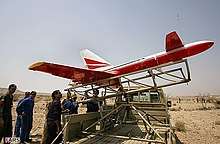
The name of the Ababil-2 surveillance variant is similarly unclear,[1] but Jane's reports that this is called the Ababil-S.[3] Some sources may also designate this the Ababil-R.[21] Galen Wright assesses it as having "only rudimentary" surveillance capabilities in contrast to other ISR UAVs.[1]
Twin-tail variant
The Ababil-2 also exists in a twin-tail variant, which some (but not all) sources name the Ababil-T.[3] This variant can be fitted with surveillance, target drone, or disposable strike munition payloads.[1] It is probably coterminous with the "Mirsad-1" UAV operated by Hezbollah[3] and may have been renamed "Qasef-1" in Houthi service.[22]
Ababil-CH
The Ababil-CH has two rear tails, like the Ababil-T, but is used as a target drone like the Ababil-B.[1][3] It is slightly larger than the Ababil-T.[22]
Qasef-1
The Qasef-1 loitering munition is based on the Ababil-2 airframe and has a 30-kg warhead.[23] It has been solely operated by Yemeni Houthis rebels, who have mostly used it to attack the radar components of MIM-104 Patriot surface-to-air missiles.[22] The Qasef-1 has been in use since late 2016 and some examples have been intercepted in transit to Yemen.[22] It is possibly simply a renamed Ababil-T.[22]
The Houthis claim that the Qasef-1 is manufactured themselves, but this claim has been broadly rejected and there is widespread agreement it is Iranian-built.[22]
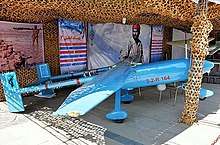
Ababil-3
The Ababil-3 is a complete redesign of the Ababil with an improved airframe used solely for surveillance.[1] Some sources also designate the Ababil-3 as the Ababil-III. It is more widely exported than the Ababil-2, and is known to have entered production by 2006.[1]

The Ababil-3 has a cylindrical body, with wings mounted on top while at the end of the body is an H-shaped twin boom. The wing design is a rectangle which after half its lengths tapers toward the wing tips. The Ababil-3's wingspan is about 7 meters, compared to 3 meters for the Ababil-2.[24] It uses an engine from German company Limbach Flugmotoren,[25] possibly the Limbach L550E.[26] The Ababil-3's max airspeed is 200 km/h (120 mph), its range is 100 km (62 mi) (roundtrip), and it has a service ceiling of 5,000 m (16,000 ft). It has an endurance of 4 hours.
In 2014 Iran announced that they had developed night vision capabilities for the Ababil-3.[27] Previous Ababil variants were most effective in daytime.
Ababil-3s have been extensively used in the Syrian Civil War.[1] The heterogeneity of pro-regime forces makes it difficult to determine who operates or controls their use.
Operators


- Aerospace Force of the Islamic Revolutionary Guard Corps: Ababil-1, Ababil-2, and Ababil-3[1]
- Islamic Republic of Iran Air Force: Ababil-3[1]
- Islamic Republic of Iran Army: Ababil-2[1]


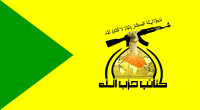



Specifications (Ababil-2)
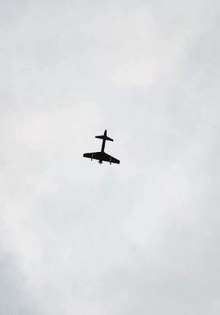
Data from Galen Wright[1] and Jane's[3]
General characteristics
- Crew: none
- Capacity: 40 kg payload
- Length: 2.88 m (9 ft 5 in)
- Wingspan: 3.25 m (10 ft 8 in)
- Height: 0.91 m (3 ft 0 in)
- Wing area: 1.76 m2 (18.9 sq ft)
- Empty weight: 30 kg (66 lb) approx.
- Max takeoff weight: 83 kg (183 lb)
- Fuel capacity: 16 liters
- Powerplant: 1 × WAE-342 twin-cylinder piston engine, 19 kW (25 hp)
- Propellers: 2-bladed
Performance
- Maximum speed: 370 km/h; 230 mph (200 kn) in level flight
- Cruise speed: 250–305 km/h (155–190 mph; 135–165 kn)
- Combat range: 120 km; 75 mi (65 nmi)
- Endurance: 1 ¼ – 2 hr
- Service ceiling: 3,000 m (9,800 ft) or higher
See also
Aircraft of comparable role, configuration and era
- Qods Mohajer[lower-alpha 2]
- SAGEM Crecerelle
- Altec MART/Altec S-MART
- Aerosonde Mk 4.7
References
- 1 2 3 4 5 6 7 8 9 10 11 12 13 14 15 16 17 18 19 20 21 22 23 24 Galen Wright (February 5, 2011). "Ababil UAV". thearkenstone.blogspot.com.
- ↑ Peterson, Zach (17 August 2012). "Are These Really Iranian Drones?". RadioFreeEurope/RadioLiberty.
- 1 2 3 4 5 6 7 8 9 10 11 12 Martin Streetly, ed. (2014). Jane's All the World's Aircraft: Unmanned 2014-2015. London: IHS Jane's. p. 79-80. ISBN 978-0710630964.
- ↑ Ronen Bergman (27 April 2012). "'Hezbollah boosting drone unit'". Ynetnews.
- 1 2 Lambeth, Benjamin S. (2011). "Air operations in Israel's war against Hezbollah: learning from Lebanon and getting it right in Gaza". RAND Corporation. Retrieved 14 August 2018.
- ↑ "الإعلام الحربي المركزي-في ذكرى #نصر_تموز... قوة #المقاومة الجوية حاضرة في #مليتا". central-media.org.
- ↑ Rawnsley, Adam (25 April 2015). "New Airstrip Could Be Home to Hezbollah's Drones".
- ↑ Dörrie, Peter (5 May 2014). "Sudan's Drones Are Dropping Like Flies".
- ↑ "Warplanes: Iranian UAVs In Africa". March 18, 2012. Retrieved 9 April 2012.
- ↑ "Iranian drone 'shot down in Iraq'". BBC News. 16 March 2009. Retrieved 16 March 2009.
- ↑ Shadid, Anthony, "U.S. Downed Iranian Drone Over Iraq", The Washington Post, p. 9.
- ↑ Nordland, Rod, and Alissa J. Rubin, "U.S. Says It Shot Down An Iranian Drone Over Iraq", The New York Times, March 17, 2009.
- ↑ "Iranian drone 'shot down in Iraq'". BBC News. March 16, 2009. Retrieved April 23, 2010.
- ↑ Special Look: Counter UAV. Foreign Military Studies Office OEWATCH, Vol. 5 Issue #04 April 2015. p. 12
- ↑ Michael R. Gordon and Eric Schmitt (June 25, 2014). "Iran Secretly Sending Drones and Supplies Into Iraq, U.S. Officials Say". New York Times.
- ↑ Dan Gettinger, (December 2016) Drones Operating in Syria and Iraq. Bard College
- ↑ Rawnsley, Adam (14 February 2015). "A Bunch of Iranian Drones Have Crashed in Iraq".
- ↑ Galen Wright (27 October 2014). "UAVs Over Syria - Open Source IMINT".
- ↑ Arie Egozi (15 December 2014). "Israel scrambles fighters as Hamas parades Ababil UAV". FlightGlobal.
- ↑ Interavia: Business & Technology, Issues 649-659 (2001)
- ↑ Peter La Franchi (15 August 2006). "Iranian-made Ababil-T Hezbollah UAV shot down by Israeli fighter in Lebanon crisis". London: Flight Global.
- 1 2 3 4 5 6 "'Kamikaze' drones used by Houthi forces to attack Coalition missile defence systems". Conflict Armament Research. March 2017.
- ↑ Jeremy Binnie (2 March 2017). "Yemeni rebels display UAVs". London: IHS Jane's.
- ↑ Nicholas Blanford (23 April 2015). "Hizbullah airstrip revealed". Beirut: IHS Jane's Defence Weekly.
- ↑ "Der Generalbundesanwalt beim Bundesgerichtshof: Pressemitteilung". www.generalbundesanwalt.de. 20 February 2013.
- ↑ US State Department (12 May 2008). "UAE-Based Intermediary Working to Supply Iranian Entity with German-Origin Uav Engines" – via WikiLeaks PlusD.
- ↑ Iranian-made Ababil-3 Swallow-3 drone is now equipped with night vision capability – Armyrecognition.com, 2 July 2014
- 1 2 International Institute for Strategic Studies (IISS) (14 February 2018). "The Military Balance 2018". The Military Balance. Routledge. 118.
- ↑ Ranter, Harro. "Hard landing Accident Ghods Ababil 3-2-R 139, 13 Oct 2015". aviation-safety.net.
- ↑ "Lost Weapons on Twitter". Twitter. 12 February 2017.
- ↑ https://medium.com/war-is-boring/a-bunch-of-iranian-drones-have-crashed-in-iraq-a7610cdb815b
- ↑ Wright, Author: Galen (5 March 2015). "The Arkenstone - ارکنستون: Mohajer UAV".
Attribution:

External links
| Wikimedia Commons has media related to Ababil. |